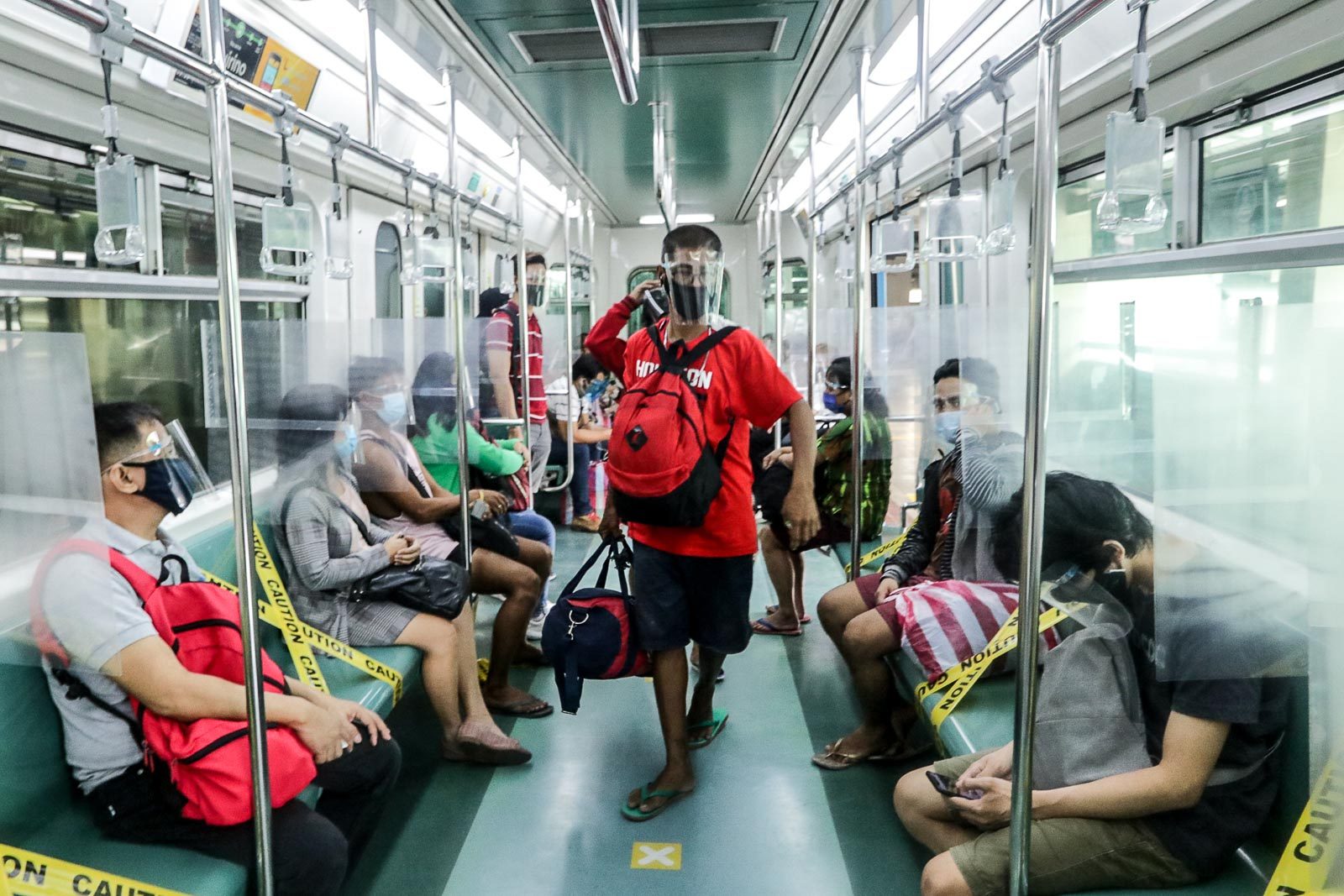SUMMARY
This is AI generated summarization, which may have errors. For context, always refer to the full article.

A broad network of civil society organizations dared government officials and business leaders pushing for reduced physical distancing in public transportation to commute for a month should the new policy be imposed.
The groups – including the COVID-19 Action Network, National Confederation of Transport Workers Union, and Health Justice – urged Department of Transportation (DOTr) officials, members of the Interagency Task Force on Emerging Infectious Diseases (IATF-EID), and leaders of business groups to accept the challenge and even bring their loved ones with them.
The groups said in a press conference on Thursday, September 17, that this way, they would see for themselves if the measure is as safe as they claim it to be.
The eased physical distancing in public transportation was implemented on September 14 but suspended 3 days later, as President Rodrigo Duterte mulls over concerns raised about the new policy.
“Kung ang mga businessmen, mga politiko ay kating-kati mag-implement ng panukalang ito, kaming mga kabataan ay hinahamon sila na mag-komyut araw-araw gamit ang pampublikong transportasyon bago sila magsalita kung ano sa tingin nila ay makakabuti sa atin,” said Dr RJ Naguit of Akbayan Youth.
(If businessmen and politicians are itching to implement this, the youth challenges them to commute every day using public transportation before they tell us what they think is best for us.)
“Kung hindi nila kayang gawin ito kasama ang kanilang mga mahal sa buhay, bakit nila pipilitin ang karaniwang Pilipino na sundin ito? Kung gusto nila, sila ang mauna,” added Naguit.
(If they can’t do this with their loved ones, why are they forcing ordinary Filipinos to follow this? If they want this, they should do it first.)
The transportation department has been pushing for eased physical distancing in public transportation, or reducing the distance between passengers from 1 meter to 0.75 meters.
With the approval of the Inter-agency Task Force on Emerging Infectious Diseases (IATF-EID), it implemented this starting Monday, September 14. It was to be gradually reduced until the distance narrowed to 0.3 meters by October 12.
Malacañang announced on Thursday that the eased policy has been suspended until Duterte decides on it, following concerns raised by some government officials themselves, and health experts.
‘No trade-off between public health and economic recovery’
The reduction in physical distancing in public transportation is part of government efforts to encourage a measured return to work and business to revive the economy.
Viviane Apostol of Action for Economic Reforms said during the press conference that the country’s economic recovery will further slow down if public health is not prioritized.
The civil society groups said in their unity statement: “There is no trade-off between protecting health and recovering the economy. This policy of reducing physical distancing will only end up further damaging the economy as it harms the health of our workers.”
Echoing concerns of urban poor communities, Ernesto Ofracio of Aktibong Kilusan Tungo sa Isang Bayan shared that the policy not only threatens the poor and the working class but also endangers senior citizens and those with non-communicable diseases like cancer who have no choice but to commute to get medical treatment.
“Marami sa aming hanay ay mas pipiliing manatili sa bahay lalo na ang mga kasaping senior citizens din. Ngunit wala kaming ganitong pribilehiyo dahil kung hindi kami magtatrabaho ay hindi rin kami makakakain. Wala naman kaming ibang paraan kundi gumamit ng pampublikong transportasyon,” said Ofracio.
(Many in our ranks would choose to stay at home, especially members who are senior citizens too. But we don’t have that privilege because if we don’t work, we can’t eat. We have no other choice but to use public transportation.)
Not the only option
Several transport groups reiterated that there are other ways to increase the supply of public transportation in the country and help revive the economy without sacrificing public safety.
Robert Siy of the Move as One Coalition cited the network’s proposal to the government to implement service contracting for all public transportation, provide infrastructure for safe walking and cycling in all cities, and prioritize investments that would improve the efficiency of public transport operations such as bus rapid transit systems, bus stops, and public utility vehicle-only lanes.
COVID-19 Action Network Philippines said they could continue to raise the commuting challenge to government officials.
“Gusto natin makita at malaman nila ang pagbaba ng physical distancing hindi talaga ligtas para sa ating komyuters…. Bakit tayo gagawin sacrificial lamb ng ating gobyerno na sa gayoon hindi pa natin nakikita ang totong implementasyon ng physical distancing?” said Kris Miranda of University of the Philippines Alyansa.
(We want them to see and experience that reduced physial distancing is not safe for our commuters…. Why do we have to be the sacrificial lambs of our government when we have not seen the actual implementation of physical distancing?)
For the groups, the 30-day challenge is enough to help the DOTr, IATF, and business leaders understand the everyday plight of commuters, and conduct an impact analysis of the measure.
The groups, including Alyansa Tigil Mina and CommutersPH, also launched a signature campaign to urge the government officials to do the challenge.
This is not the first time groups called on government officials to try commuting to experience the plight of commuters.
In 2019, then Presidential Spokesman Salvador Panelo accepted the challenge by progressive groups to commute from his home in Marikina City to Malacañang, after he denied the mass transportation crisis in the Philippines amid disruptions in LRT2 operations and hellish traffic jams in Metro Manila. – Rappler.com
Add a comment
How does this make you feel?


![[Time Trowel] Evolution and the sneakiness of COVID](https://www.rappler.com/tachyon/2024/02/tl-evolution-covid.jpg?resize=257%2C257&crop=455px%2C0px%2C1080px%2C1080px)


There are no comments yet. Add your comment to start the conversation.